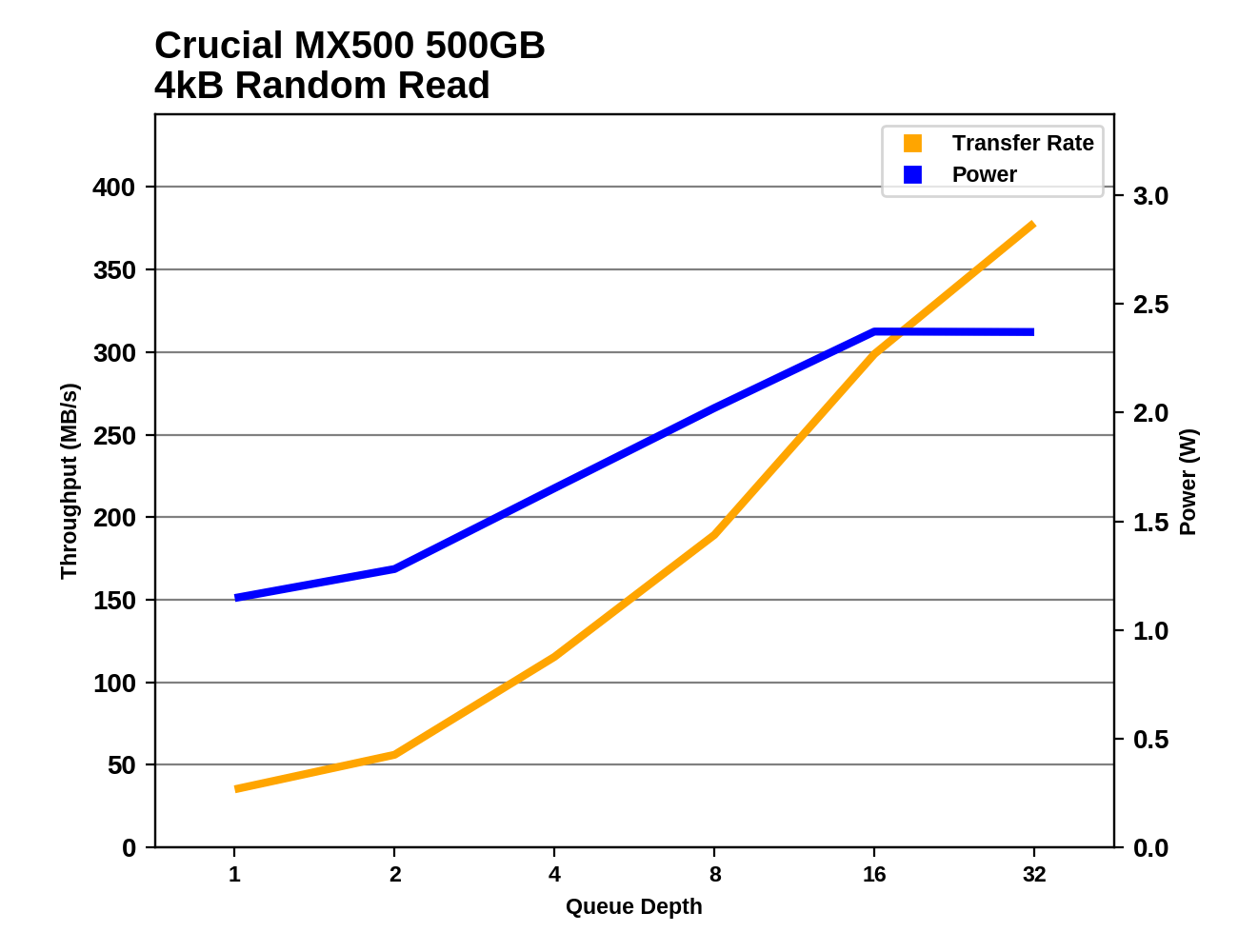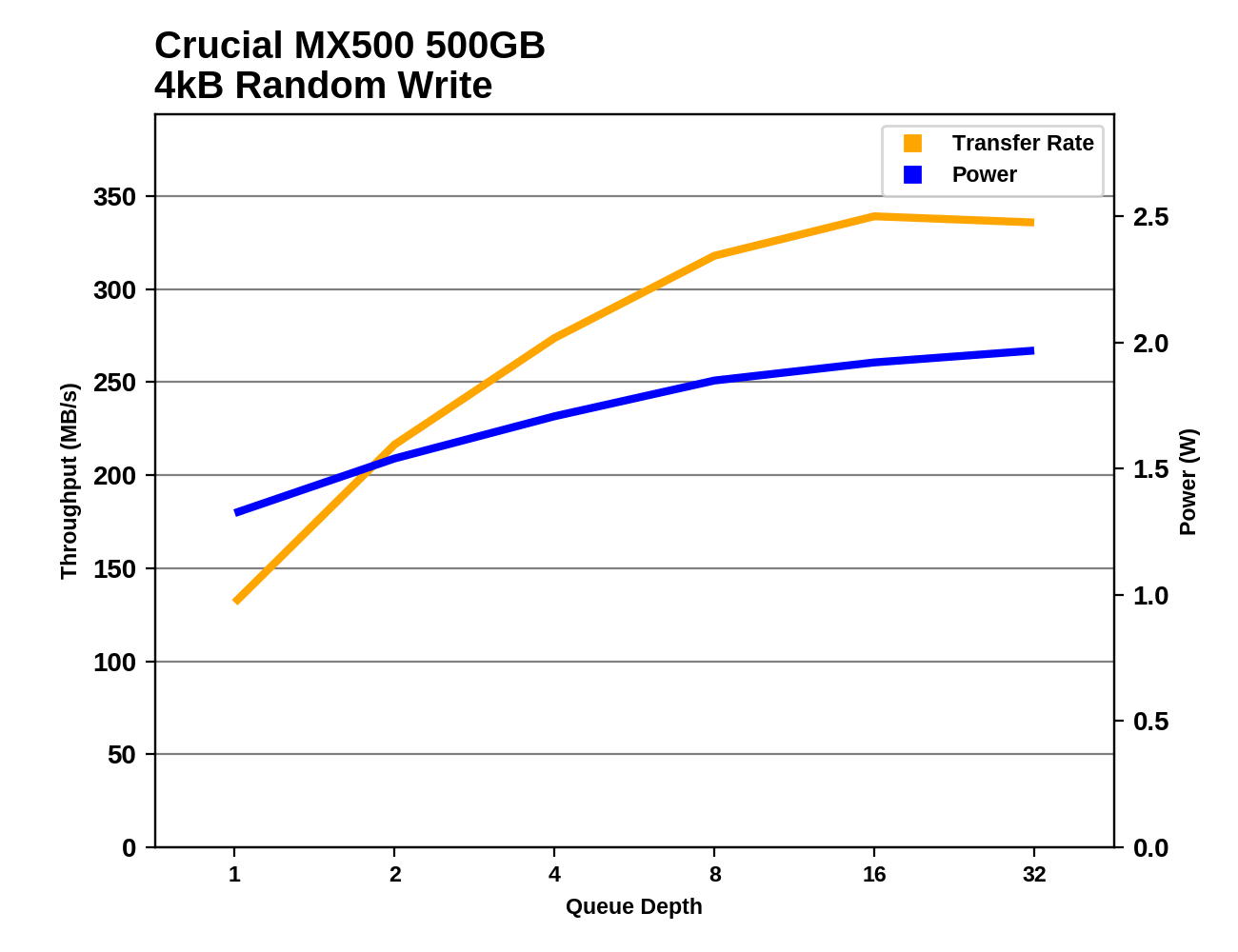The Crucial MX500 500GB SSD Review: A Second Look
by Billy Tallis on February 2, 2018 9:30 AM ESTRandom Read Performance
Our first test of random read performance uses very short bursts of operations issued one at a time with no queuing. The drives are given enough idle time between bursts to yield an overall duty cycle of 20%, so thermal throttling is impossible. Each burst consists of a total of 32MB of 4kB random reads, from a 16GB span of the disk. The total data read is 1GB.

The 500GB Crucial MX500 isn't quite as fast as its 1TB sibling on the burst random read performance test, but it still scores better than any other TLC we've tested. The Samsung 860 EVO might be able to beat the MX500's performance here when it arrives, but probably not my much.
Our sustained random read performance is similar to the random read test from our 2015 test suite: queue depths from 1 to 32 are tested, and the average performance and power efficiency across QD1, QD2 and QD4 are reported as the primary scores. Each queue depth is tested for one minute or 32GB of data transferred, whichever is shorter. After each queue depth is tested, the drive is given up to one minute to cool off so that the higher queue depths are unlikely to be affected by accumulated heat build-up. The individual read operations are again 4kB, and cover a 64GB span of the drive.

With longer queue depths and test run times, the MX500's random read performance falls from first place to merely above average. The MX500 is still the fastest Crucial SSD, but it is substantially slower than the Samsung SATA drives and is not quite as fast as the Intel 545s.

The power efficiency of the Crucial MX500 during the random read test is better than any previous Crucial SSD, but the Intel 545s and Samsung 850 EVO outscore it significantly. The 860 EVO will only widen this gap.
 |
|||||||||
The Intel 545s and the Crucial MX500 perform about the same until QD16 where the 545s starts to level off. The Samsung 850 EVO starts building a lead on the MX500 at much lower queue depths, so it reach es peak performance much earlier. Both of those competitors use less power than the MX500 throughout the random read test.
Random Write Performance
Our test of random write burst performance is structured similarly to the random read burst test, but each burst is only 4MB and the total test length is 128MB. The 4kB random write operations are distributed over a 16GB span of the drive, and the operations are issued one at a time with no queuing.

The burst random write speed of the 500GB Crucial MX500 is a disappointment, coming in slower than most of its competition and 25% slower than the 1TB model.
As with the sustained random read test, our sustained 4kB random write test runs for up to one minute or 32GB per queue depth, covering a 64GB span of the drive and giving the drive up to 1 minute of idle time between queue depths to allow for write caches to be flushed and for the drive to cool down.

The Crucial MX500 500GB doesn't fare quite as badly on the longer random write test. It's still one of the slower drives in the bunch, but not by such a wide margin, and it is only a little bit slower than the 1TB model.

The Crucial MX500 has good power efficiency during random writes, but both the MX300 and BX300 are slightly better, and the Samsung 860 PRO's large lead suggests the 860 EVO may also be in competition for the most efficient TLC SSD.
 |
|||||||||
The Crucial MX500 takes longer to get up to speed than the Samsung 850 EVO, but it does eventually get up to full speed matching the best SATA SSDs. Previous Crucial SSDs and the Intel 545s struggle to get up to the level of Samsung's random write performance even at QD32.










25 Comments
View All Comments
jordanclock - Friday, February 2, 2018 - link
Generally, any good SATA SSD is going offer much the same performance as any other model. The gains when going from the second (or even fifth) best SSD on SATA to the absolute best are tiny. Plus, given the capacity you would want for a console, I think going for a 'mediocre' SSD will offer all the performance you need without spending twice as much for less than one second load time differences.leexgx - Tuesday, February 20, 2018 - link
this is true once you have a SSD (any) in a console your purely limited by the CPU speed and ram in the PS4 or xbox it self (some youtubers have tested it) even to the point the SSHD from seagate and toshiba after the second load is nearly the same as a SSD (but it has to have read the data before so if you load the same game or save twice for it work well witch mite happen if you die a lot and fall back to a checkpoint save) if you switch between games SSHDs can at times offer not as much benerfitstill can't beat SSDs for consistency as it always be the same speed
tamalero - Friday, February 2, 2018 - link
Those prices feel really nice!Hurr Durr - Sunday, February 4, 2018 - link
It's not nice until we hit around 10 cents for the gigabyte.zirk65 - Friday, February 2, 2018 - link
Looks similar to the MX200, but with bigger pipes and better thermals.MX200 = MLC NAND / Marvel Controller
MX500 = TLC NAND / Silicon Motion Controller
Yet I wonder much is different between the controller uArch these days, outside of specific I/O and power functions.
mode_13h - Friday, February 2, 2018 - link
Last I checked, Crucial's MX-series SSDs featured end-to-end data protection. Does Samsung offer anything like that, in their consumer drives?letmepicyou - Friday, February 2, 2018 - link
Say Mr. Tallis, I'm sure I'm not alone when I ask this (feel free to chime in, guys) but there are those of us out here who want the greater capacity of a 1tb drive whilst not wanting to fork over 1tb drive prices. I can RAID 0 a pair of ~500gb drives and get better performance than a single 1tb drive, while spending $60-$120 less.What I'm saying is, I would love to see how your arsenal of ~500 gb drives perform in RAID. I have a feeling others would like to see the same information.
Billy Tallis - Friday, February 2, 2018 - link
You can't get a pair of 500GB drives for $60 less than the price of a 1TB drive from the same product line, unless you're looking at an unusually good sale on the 500GB drives and not looking for the best price on a 1TB drive. Every 1TB SATA drive I price checked this week was cheaper per GB than its half-TB counterpart.As for RAID testing, my collection of drives almost never includes more than one of each. At the moment I'm finishing up a NVMe RAID review using a set of drives that was loaned by a vendor specifically for this review. Between the disappointing results I'm getting from that project and the prices I'm seeing that don't make SATA RAID economical either, it's not a priority for me to test SATA RAID.
Wardrop - Saturday, February 3, 2018 - link
Is that a software raid or hardware raid you used for your NVMe raid review. I'm guessing software as I'm not even sure any NVMe raid solutions exist. In that case, I imagine we're back to needing dedicated RAID controller to deal with the order of magnitude increase in drive performance compared to HDD's, and then obviously you're left questioning who needs double the increase in sequential performance when a single drive is usually more than fast enough for any sequential workload.peevee - Monday, February 5, 2018 - link
Check m.2 PCIe/NVMe 1TB and 2TB prices.But you'll need an MB with 2 M.2 slots with 4x PCIe connected to CPU, are those even available? Otherwise latencies will dominate the performance (like for M.2 which only provide SATA, either slots or drives).